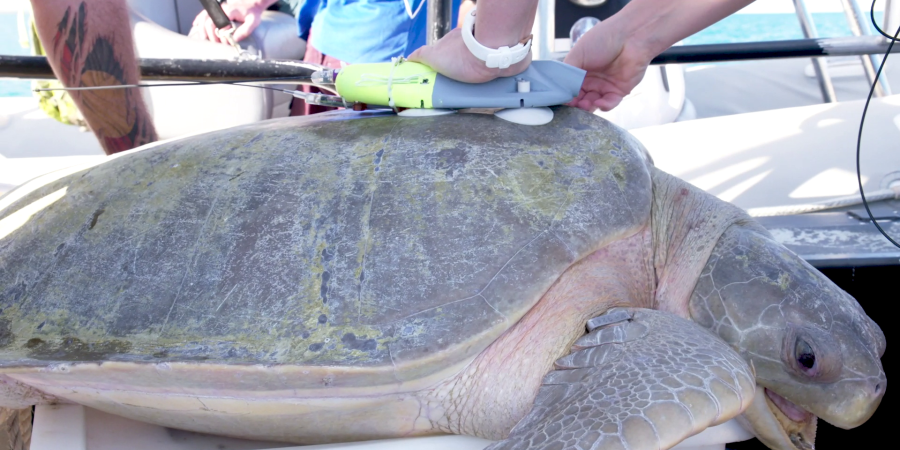
A data logger is applied to the carpace of a flatback turtle. Credit: Nyamba Buru Yawuru, DBCA
Scientists from the Department of Biodiversity, Conservation and Attractions (DBCA) and Murdoch University have turned to artificial intelligence (AI) to sift through billions of data points to uncover how a threatened turtle species uses habitat in Broome’s Yawuru Nagulagun Roebuck Bay.
The flatback turtle (Natator depressus) is endemic to northern Australia and although females come ashore to lay their eggs, little is known about the species’ behaviour at sea.
Lead author and PhD candidate Jenna Hounslow said the study highlighted how machine learning – a version of AI – can help researchers make sense of vast troves of data collected from multi-sensor data loggers, to link animal behaviour in time and space.
“We attached motion sensors to turtles, such as those in your smart watch, that recorded high-resolution data (50 times per second) to paint a detailed picture about where turtles were and what they were doing underwater where we can’t easily see them,” Ms Hounslow said.
“Some of the data loggers also included video cameras. This allowed us to use the behaviours observed in 83 hours of video to teach our AI system how to accurately identify resting and foraging behaviours from data alone.”
“Using machine learning means we can make sense of the enormous amounts of data being generated – a task that would be challenging and time-consuming for humans to do unassisted.”
With this innovative approach the researchers discovered that the turtles rest and forage in the same locations, but seasonal water temperature differences and the region’s famously large tides mean that the foraging locations change throughout the year.
“Our study has uncovered previously unknown habitat use by flatback turtles in Roebuck Bay,” Ms Hounslow said.
“We found that flatback turtles rest on the sea floor near the edge of intertidal areas and forage around tidal patterns, instead of a day/night cycle.”
DBCA scientist and PhD co-supervisor Dr Sabrina Fossette-Halot said the study provides valuable data that can aid the evaluation and planning of conservation zones such as marine parks.
“Understanding how turtles are using different parts of their habitat throughout the year is critical for conservation planning and prioritising actions,” Dr Fossette-Halot said.
“Resting or foraging turtles may be disturbed by vessel traffic or other human activities at sea, so it is essential we understand where these turtles are choosing to rest and feed.”
Murdoch University senior lecturer and senior author Dr Adrian Gleiss said machine learning techniques are an exciting tool that can improve the understanding and conservation of marine fauna.
“Marine species are difficult to observe directly and multi-sensor data loggers can produce an overwhelming amount of data, so this new technique could be the key to unlocking the behaviour of a number of threatened species,” Dr Gleiss said.
The study “Behaviour-specific spatiotemporal patterns of habitat use by sea turtles revealed using biologging and supervised machine learning” was published in the Journal of Applied Ecology.
The project was a collaboration between DBCA’s North West Shelf Flatback Turtle Conservation Program and Nyamba Buru Yawuru. Research was conducted on Yawuru Sea Country within the jointly-managed Yawuru Nagulagun Roebuck Bay Marine Park since 2018, with collaborative field support from Yawuru Rangers and Yawuru Country Managers. The research was funded by DBCA and Murdoch University and supported by the Ecological Society of Australia Holsworth Wildlife Research Endowment.
Journal reference: Hounslow, JL, Fossette, S, Chong, W, Bali, R, Tucker, AD, Whiting, SD, Gleiss, AC 2023, ‘Behaviour-specific spatiotemporal patterns of habitat use by sea turtles revealed using biologging and supervised machine learning’, Journal of Applied Ecology, DOI: 10.1111/1365-2664.14438
Available online: https://besjournals.onlinelibrary.wiley.com/doi/10.1111/1365-2664.14438